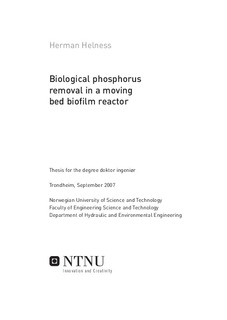| dc.contributor.author | Helness, Herman | nb_NO |
| dc.date.accessioned | 2014-12-19T12:31:07Z | |
| dc.date.available | 2014-12-19T12:31:07Z | |
| dc.date.created | 2007-12-17 | nb_NO |
| dc.date.issued | 2007 | nb_NO |
| dc.identifier | 123103 | nb_NO |
| dc.identifier.isbn | 978-82-471-3893-9 | nb_NO |
| dc.identifier.uri | http://hdl.handle.net/11250/242070 | |
| dc.description.abstract | Phosphorus (P) and nitrogen (N) removal from municipal wastewater is performed to prevent or reduce eutrophication in the receiving water.
Both P and N can be removed physical/chemically as well as biologically. While biological processes have always dominated in N-removal, chemical P-removal is used in many cases. Biological P-removal using enhanced biological phosphorus removal (EBPR) is normally carried out in suspended culture (activated sludge) processes while biological N-removal (through nitrification and denitrification) can be done in biofilm processes as well. There are, however, potential advantages related to sludge separation and required reactor volumes, which suggest that a pure biofilm process can be an interesting alternative to activated sludge for biological phosphorus and nitrogen removal.
The scope of this study was to investigate use of the moving bed biofilm reactor (MBBR) process for biological phosphorus removal. The goal has been to describe the operating conditions required for biological phosphorus and nitrogen removal in a MBBR operated as a sequencing batch reactor (SBR), and determine dimensioning criteria for such a process.
Laboratory scale experiments were performed with constructed wastewater and verified in experiments with municipal wastewater. The results showed that biological phosphorus and nitrogen removal can be achieved in a moving bed biofilm reactor operated as a SBR. The required operating conditions will be dependant on the wastewater quality. Recommended first generation design criteria for a wastewater with a typical nutrient distribution: COD:N:P ~ 100:10:2 were found.
Oxalobacter sp. was probably the most common bacteria in the biomass and may be a phosphorus accumulating bacteria. This has not been reported previously, however, further studies are required to prove or disprove the possible involvement of Oxalobacter sp. in EBPR. | nb_NO |
| dc.language | eng | nb_NO |
| dc.publisher | Fakultet for ingeniørvitenskap og teknologi | nb_NO |
| dc.relation.ispartofseries | Doktoravhandlinger ved NTNU, 1503-8181; 2007:177 | nb_NO |
| dc.title | Biological Phosphorus Removal in a Moving Bed Biofilm Reactor | nb_NO |
| dc.type | Doctoral thesis | nb_NO |
| dc.contributor.department | Norges teknisk-naturvitenskapelige universitet, Fakultet for ingeniørvitenskap og teknologi, Institutt for vann- og miljøteknikk | nb_NO |
| dc.description.degree | dr.ing. | nb_NO |
| dc.description.degree | dr.ing. | en_GB |
